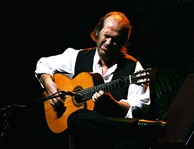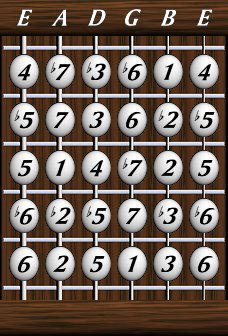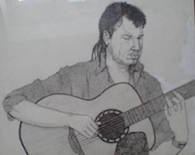Welcome to one of the most active flamenco sites on the Internet. Guests can read most posts but if you want to participate click here to register.
This site is dedicated to the memory of Paco de Lucía, Ron Mitchell, Guy Williams, Linda Elvira, Philip John Lee, Craig Eros, Ben Woods, David Serva and Tom Blackshear who went ahead of us.
We receive 12,200 visitors a month from 200 countries and 1.7 million page impressions a year. To advertise on this site please contact us.
|

|
|
Flamenco and 'The Modes'?
|
You are logged in as Guest
|
|
Users viewing this topic: none
|
|
Login  | |
|
Guest

|
 RE: Flamenco and 'The Modes'? (in reply to britguy) RE: Flamenco and 'The Modes'? (in reply to britguy)
|
|
|
The 'modes' used say in solea in E ( no Capo/por arriba Would be
E Phrygian Dominant ( derived from A harmonic minor ) E F G# A B C D
E Phrygian ( derived from C major or A natural minor ) E F G A B C
Juxtaposed depending on rythmic placement and resolution to the Phrygian tonic
Though other tones could be added - such as D# - depending on Rythmn placement
I say derived from a western music sense but would be viewed differently from another cultural perspective I imagine ..
The letra chords are from these modes but may be considered (?) tonal in function - clarification might be needed
_____________________________
|
|
|
|
REPORT THIS POST AS INAPPROPRIATE |
Date Oct. 19 2014 21:02:07
 |
|

   
Ricardo
Posts: 14801
Joined: Dec. 14 2004
From: Washington DC

|
 RE: Flamenco and 'The Modes'? (in reply to britguy) RE: Flamenco and 'The Modes'? (in reply to britguy)
|
|
|
quote:
ORIGINAL: britguy
Some years back I recall reading somewhere that Soleares is always played in the "Phrygian Mode".
Not having had any formal musical education I am only casually acquainted with modal music as it relates to the British folk tradition. Viz: Aeolian;Dorian; Phrygian; Myxolidian, etc.
Assuming that most flamenco is 'modal' music (is it?) - can anyone advise what popular flamenco palos are played in what 'mode'?
Won't help my lousy playing, but interested to know. . .
Bare with me for a short mode lesson. Simply put, modes don't "go anywhere" harmonically. Keys on the other hand, derive from the modes but require a tonic to dominant relation, specifically V chord to I chord. First, mode examples:
Ionian mode...happy major sounding. at a loss for a proper song now as it is easy to confuse with songs in a MAJOR KEY which is different. Simply put, an ionian song in C can use chords like C, F, Dminor, E minor, but must AVOID ever going G7-C.
Dorian: old church modes of gregorian chant are a favorite. Modern music vamps would be songs like "So What" by miles davis, or "oye como va" by santana.
Lydian: also happy, but sort of nostalgic sounding or exotic. Simpson's theme song.
Mixolydian: happy but sort of blues and infact used in jazz and blues a lot. The song "tequilla". In flamenco we have "caballo negro" by sanlucar.
Aeolian: the minor key cousin of Ionian. In the sense some songs use this mode are confused with songs in a minor KEY, again, no V-i allowed. In E minor that means, no B7 chord. So "beat it" by michael jackson is a good example of aeolian. In flamenco we have the ending of "entre dos aguas".
phrygian: This mode is so popular in middle eastern music but function much better in it's phrygian dominant form. That being with a raised 3rd. Not to be confused with being in a Minor key, it has to not "resolve". I only hear the proper minor phrygian used in some mediterranean songs, for example in turkey or greece. None would be good examples for laymen I think. Phrygian dominant versions on the other hand are super common. Nagila Hava is a good example.
Locrian: no good exmple of it's application as it is typcially avoided due to it's root and 5th relation being strange. For sure it is effective as a dark scary mood in pieces that might go in several different directions.
So you also have interesting modes of other types of scales and have different names but I won't go into examples.
What is important is to now understand keys. Listening to Bach for example, if it bright and happy, it's a major key piece. If it is dark and sad it is a minor key piece. Within that scope, unlike modal examples as above, the music is free to venture into other territorys by changing the TONIC. THis is done thanks the V-I relation I described earlier.
Flamenco music is the same as Bach with an interesting difference. it makes use of a Phyrigain KEY, I call it spanish phrygian. That being the music allows a tonic just as the modal examples above, but can actually GO places harmonically away from that. Examples:
Alegrias: Major key
Farruca: minor key
Siguiriya/Solea: spanish phrygian key, sometimes Major key
Fandango/malagueña/taranta/granaina/etc: spanish phyrigian with modulation to relative major. Ephyrigian->C major->E phrygian for example.
Some flamenco makes use of modal ideas too, but it is not as common as the above generalizations. The spanish phrygian used in flamenco music as a key makes clever use of the flat second scale degree as a functional tonal harmony (II-I), in place of the V-I of major of V-i of minor keys in order to establish a key tonic instead of a modal vibe that goes nowhere (as in all the modal examples above).
Just as Ionian can be confused for Major keys or Aeolian with minor keys, the phrygian dominant often gets wrongly used as a description of music that is actually having a harmonic function, such as flamenco forms mentioned.
Hope that helps some.
Ricardo
_____________________________
CD's and transcriptions available here:
www.ricardomarlow.com
|
|
|
|
REPORT THIS POST AS INAPPROPRIATE |
Date Oct. 19 2014 22:08:19
 |
|

  
pink
Posts: 570
Joined: Jan. 8 2013

|
 RE: Flamenco and 'The Modes'? (in reply to Ricardo) RE: Flamenco and 'The Modes'? (in reply to Ricardo)
|
|
|
quote:
ORIGINAL: Ricardo
quote:
ORIGINAL: britguy
Some years back I recall reading somewhere that Soleares is always played in the "Phrygian Mode".
Not having had any formal musical education I am only casually acquainted with modal music as it relates to the British folk tradition. Viz: Aeolian;Dorian; Phrygian; Myxolidian, etc.
Assuming that most flamenco is 'modal' music (is it?) - can anyone advise what popular flamenco palos are played in what 'mode'?
Won't help my lousy playing, but interested to know. . .
Bare with me for a short mode lesson. Simply put, modes don't "go anywhere" harmonically. Keys on the other hand, derive from the modes but require a tonic to dominant relation, specifically V chord to I chord. First, mode examples:
Ionian mode...happy major sounding. at a loss for a proper song now as it is easy to confuse with songs in a MAJOR KEY which is different. Simply put, an ionian song in C can use chords like C, F, Dminor, E minor, but must AVOID ever going G7-C.
Dorian: old church modes of gregorian chant are a favorite. Modern music vamps would be songs like "So What" by miles davis, or "oye como va" by santana.
Lydian: also happy, but sort of nostalgic sounding or exotic. Simpson's theme song.
Mixolydian: happy but sort of blues and infact used in jazz and blues a lot. The song "tequilla". In flamenco we have "caballo negro" by sanlucar.
Aeolian: the minor key cousin of Ionian. In the sense some songs use this mode are confused with songs in a minor KEY, again, no V-i allowed. In E minor that means, no B7 chord. So "beat it" by michael jackson is a good example of aeolian. In flamenco we have the ending of "entre dos aguas".
phrygian: This mode is so popular in middle eastern music but function much better in it's phrygian dominant form. That being with a raised 3rd. Not to be confused with being in a Minor key, it has to not "resolve". I only hear the proper minor phrygian used in some mediterranean songs, for example in turkey or greece. None would be good examples for laymen I think. Phrygian dominant versions on the other hand are super common. Nagila Hava is a good example.
Locrian: no good exmple of it's application as it is typcially avoided due to it's root and 5th relation being strange. For sure it is effective as a dark scary mood in pieces that might go in several different directions.
So you also have interesting modes of other types of scales and have different names but I won't go into examples.
What is important is to now understand keys. Listening to Bach for example, if it bright and happy, it's a major key piece. If it is dark and sad it is a minor key piece. Within that scope, unlike modal examples as above, the music is free to venture into other territorys by changing the TONIC. THis is done thanks the V-I relation I described earlier.
Flamenco music is the same as Bach with an interesting difference. it makes use of a Phyrigain KEY, I call it spanish phrygian. That being the music allows a tonic just as the modal examples above, but can actually GO places harmonically away from that. Examples:
Alegrias: Major key
Farruca: minor key
Siguiriya/Solea: spanish phrygian key, sometimes Major key
Fandango/malagueña/taranta/granaina/etc: spanish phyrigian with modulation to relative major. Ephyrigian->C major->E phrygian for example.
Some flamenco makes use of modal ideas too, but it is not as common as the above generalizations. The spanish phrygian used in flamenco music as a key makes clever use of the flat second scale degree as a functional tonal harmony (II-I), in place of the V-I of major of V-i of minor keys in order to establish a key tonic instead of a modal vibe that goes nowhere (as in all the modal examples above).
Just as Ionian can be confused for Major keys or Aeolian with minor keys, the phrygian dominant often gets wrongly used as a description of music that is actually having a harmonic function, such as flamenco forms mentioned.
Hope that helps some.
Ricardo
You really know how to be most generous with your knowledge. Not an ounce of the ''know it all tosser '' syndrome.... just good ,honest info and advice.
F ekkin nice one!
_____________________________
|
|
|
|
REPORT THIS POST AS INAPPROPRIATE |
Date Oct. 19 2014 22:39:37
 |
|
Guest

|
 RE: Flamenco and 'The Modes'? (in reply to Ricardo) RE: Flamenco and 'The Modes'? (in reply to Ricardo)
|
|
|
Thanks for the clarification Ricardo
Edit
Putting Bach together with the Phrygian tonic is a great bit of info
Cheers
_____________________________
|
|
|
|
REPORT THIS POST AS INAPPROPRIATE |
Date Oct. 20 2014 3:47:20
 |
|

   
Ricardo
Posts: 14801
Joined: Dec. 14 2004
From: Washington DC

|
 RE: Flamenco and 'The Modes'? (in reply to Sr. Martins) RE: Flamenco and 'The Modes'? (in reply to Sr. Martins)
|
|
|
quote:
ORIGINAL: Sr. Martins
People often get too entangled in modes names and end up not doing anything useful with them.
It surely helps if you just take the major scale as 1234567 and then look at the modes as alterations to that scale. Instead of lydian you would simply think (and hear) 123#4567, mixolydian would be 123456b7 and so on.
Try it if you feel that you haven't quite grasped the modes.
This certainly works if the player knows the fingerboard pretty well, for example how to find b7 or #4 on the neck. I recommend further that an open bass string be played always as the "1" bass like a drone, and play the other notes on the other 5 strings in order to hear the relation. Further, I recommend practing the playing/listening exercise changing modes in a specific order. For example:
Play all modes in E so you hear open 6th string bass note:
E lydian =123#4567
E ionian= 1234567
E mixolydian=123456b7
E dorian = 12b3456b7
E aeolian = 12b345b6b7
E phyrgian = 1b2b345b6b7
E locrian = 1b2b34b5b6b7
THis way you can hear the mood change between the modes (bright to dark in this case) and notice that between each change, only one note in the scale differs, so it is easier to visualize the relationships on the fingerboard.
quote:
Thanks for the clarification Ricardo
Edit
Putting Bach together with the Phrygian tonic is a great bit of info
Cheers
_____________________________
It can be very frustrating to convey the idea of phrygian key/tonic to western eared musicians that know theory pretty well. They only understand music as major or minor keys or modes. Pretty much they argue that something like Solea and Farruca are the same thing musically, it's just that solea is "hanging on the V chord in minor"... implying both must be in the key of A minor. I next try to exmplain the difference is in the rhythmic phrasing but it is a hard sell. I try to use Mozart as an example, as after Bach's time he and his contemporaties used a harmonic device called Augmented 6th chords. That would be like doing F7-E7-Am, in Farruca. The dominant F7 pulls stronger to the E7 and breifly tonicizes the E chord by spelling the F7 chord with a D# instead of Eb...making a leading tone voice that resolves to E nicely.
This device is used to pull away from A minor breifly and is exactly the type of thing we see in flamenco with Solea etc. THe difference being is rhythmically, the music ends there on the E and need not continue to Aminor interms of phrasing. It is a weaker resolve perhaps than good ol major or minor V-I moves, but functions in the world of tonal harmony none the less, and is much more than just a simple modal vamping concept because it allows all the other types of harmonic movement tonal harmony provides.
_____________________________
CD's and transcriptions available here:
www.ricardomarlow.com
|
|
|
|
REPORT THIS POST AS INAPPROPRIATE |
Date Oct. 20 2014 16:42:27
 |
|
 New Messages New Messages |
 No New Messages No New Messages |
 Hot Topic w/ New Messages Hot Topic w/ New Messages |
 Hot Topic w/o New Messages Hot Topic w/o New Messages |
 Locked w/ New Messages Locked w/ New Messages |
 Locked w/o New Messages Locked w/o New Messages |
|
 Post New Thread
Post New Thread
 Reply to Message
Reply to Message
 Post New Poll
Post New Poll
 Submit Vote
Submit Vote
 Delete My Own Post
Delete My Own Post
 Delete My Own Thread
Delete My Own Thread
 Rate Posts
Rate Posts
|
|
|
Forum Software powered by ASP Playground Advanced Edition 2.0.5
Copyright © 2000 - 2003 ASPPlayground.NET |
0.09375 secs.
|


 Printable Version
Printable Version














 New Messages
New Messages No New Messages
No New Messages Hot Topic w/ New Messages
Hot Topic w/ New Messages Hot Topic w/o New Messages
Hot Topic w/o New Messages Locked w/ New Messages
Locked w/ New Messages Locked w/o New Messages
Locked w/o New Messages Post New Thread
Post New Thread